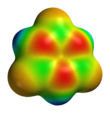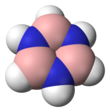Borazine

| |||
| |||
| Names | |||
|---|---|---|---|
| Preferred IUPAC name
1,3,5,2,4,6-Triazatriborinane (only preselected[1]) | |||
| Other names
Cyclotriborazaneborazol
Inorganic benzene Borazole | |||
| Identifiers | |||
3D model (
JSmol ) |
|||
| ChEBI | |||
| ChemSpider | |||
ECHA InfoCard
|
100.169.303 | ||
PubChem CID
|
|||
| UNII | |||
CompTox Dashboard (EPA)
|
|||
| |||
| |||
| Properties | |||
| B3H6N3 | |||
| Molar mass | 80.50 g/mol | ||
| Appearance | Colorless liquid | ||
| Density | 0.81 g/cm3 | ||
| Melting point | −58 °C (−72 °F; 215 K) | ||
| Boiling point | 53 °C (127 °F; 326 K) (55 °C at 105 Pa) | ||
| -49.6·10−6 cm3/mol | |||
| Hazards | |||
| NFPA 704 (fire diamond) | |||
Except where otherwise noted, data are given for materials in their standard state (at 25 °C [77 °F], 100 kPa).
| |||
Borazine, also known as borazole, is an
Synthesis
The compound was reported in 1926 by the chemists Alfred Stock and Erich Pohland by a reaction of diborane with ammonia.[3]
Borazine can be synthesized by treating diborane and ammonia in a 1:2 ratio at 250–300 °C with a conversion of 50%.
- 3 B2H6 + 6 NH3 → 2 B3H6N3 + 12 H2
An alternative more efficient route begins with sodium borohydride and ammonium sulfate:[4]
- 6 NaBH4 + 3 (NH4)2SO4 → 2 B3N3H6 + 3 Na2SO4 + 18 H2
In a two-step process to borazine, boron trichloride is first converted to trichloroborazine:
- 3 BCl3 + 3 NH4Cl → Cl3B3H3N3 + 9 HCl
The B-Cl bonds are subsequently converted to B-H bonds:
- 2 Cl3B3H3N3 + 6 NaBH4 → 2 B3H6N3 + 3 B2H6 + 6 NaCl
Structure
Borazine is isoelectronic with benzene and has similar connectivity, so it is sometimes referred to as "inorganic benzene". This comparison is not rigorously valid due to the electronegativity difference between boron and nitrogen. X-ray crystallographic structural determinations show that the bond lengths within the borazine ring are all equivalent at 1.429 Å, a property shared by benzene.[5] However, the borazine ring does not form a perfect hexagon. The bond angle is 117.1° at the boron atoms and 122.9° at the nitrogens, giving the molecule the D3h symmetry point group.
The

Boron behaves as a
Aromaticity
Due to its similarities to benzene, there have been a number of computational and experimental analyses of borazine's
Natural bond orbitals (NBO)
Natural bond orbital (NBO) analysis suggests weak aromaticity in borazine.[6] In the NBO model, B-N bonds in the ring are slightly displaced from the nuclear axes, and B and N have large differences in charge. Natural chemical shielding (NCS) analysis provides some further evidence for aromaticity based on a contribution of the B-N π bond to magnetic shielding. Computations based on NBO orbitals show that this π bond allows for weak ring current which somewhat counteracts a magnetic field simulated at the center of the borazine ring. A small ring current does suggest some delocalization.
Electron localization function (ELF)
Topological analysis of bonding in borazine by the electron localization function (ELF) indicates that borazine can be described as a π aromatic compound. However, the bonding in borazine is less delocalized than in benzene based on a difference in bifurcation values of the electron basins. Larger bifurcation values indicate better electron delocalization, and it is argued that when this bifurcation value is greater than 0.70, the delocalization is sufficient to designate a compound aromatic.[7] For benzene, this value is 0.91, but the borazine π system bifurcates at the ELF value 0.682.[8] This is caused by the difference in electronegativity between B and N, which produces a weaker bond interaction than the C-C interaction in benzene, leading to increased localization of electrons on the B-H and N-H units. The bifurcation value is slightly below the limit of 0.70 which suggests moderate aromaticity.
Reactivity
Hydrolysis
Borazine hydrolyzes readily, yielding boric acid, ammonia, and hydrogen.
Polymerization

Heating borazine at 70 °C expels hydrogen with formation of polyborazylene:
- n B3N3H6 → 1/n[B3N3H4]n
With hydrogen halides and halogens
With hydrogen chloride it forms an adduct.
- B3N3H6 + 3 HCl → B3N3H9Cl3
- Addition reaction of borazine with hydrogen chloride
- B3N3H9Cl3 + NaBH4 → (BH4N)3
- Reduction with sodium borohydride
The addition reaction with
Ceramic precursor
Boron nitride can be prepared by heating polyborazylene to 1000 °C.[4]
Borazines are also starting materials for other potential ceramics such as boron carbonitrides. Borazine can also be used as a precursor to grow hexagonal boron nitride (h-BN) thin films and single layers on catalytic surfaces such as copper,[9] platinum,[10] nickel[11] iron[12] and many more, with chemical vapor deposition (CVD).

Polyborazylene has been proposed as a recycled
Among other B-N type compounds mixed amino-nitro substituted borazines have been predicted to outperform carbon based explosives such as
Related compounds
(C
2H
2B
2N
2) is a six-membered aromatic ring with two carbon atoms, two nitrogen atoms, and two boron atoms in opposing pairs.[16][17]
1,2-Dihydro-1,2-azaborine (C
4BNH
6) is a six-membered ring with four carbon atoms, one nitrogen atom, and one boron atom.
See also
Further reading
- Nelson, Ralph; et al. (September 1, 1967). "Selected values of electric dipole moments for molecules in the gas phase" (PDF). American National Bureau of Standards (10): 17.
References
- ISBN 978-0-85404-182-4.
- ISBN 978-1429218207.
- .
- ^ ISBN 9780470132630.
- .
- .
- PMID 15268298.
- S2CID 95098134.
- PMID 25673919.
- PMID 23527543.
- ISSN 0897-4756.
- PMID 25664483.
- PMID 19514023.
- .
- S2CID 9774352.
- S2CID 94792421.
- PMID 26411675.
Further reading
- Sneddon LG, Mirabelli MG, Lynch AT, Fazen PJ, Su K, Beck JS (1991). "Polymeric precursors to boron based ceramics" (PDF). Pure Appl. Chem. 63 (3): 407–410. S2CID 53629042.
- Jeon JK, Uchimaru Y, Kim DP (August 2004). "Synthesis of novel amorphous boron carbonitride ceramics from the borazine derivative copolymer via hydroboration". Inorganic Chemistry. 43 (16): 4796–8. PMID 15285647.
- Paetzold P (1991). "New perspectives in boron-nitrogen chemistry - I" (PDF). Pure Appl. Chem. 63 (3): 345–350. S2CID 53659373.
- Islas R (2007). "Borazine: to be or not to be aromatic". Structural Chemistry. 18 (6): 833–839. S2CID 95098134.
External links
![]() Media related to borazine at Wikimedia Commons
Media related to borazine at Wikimedia Commons



